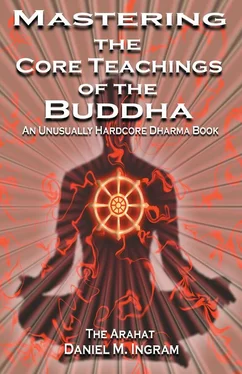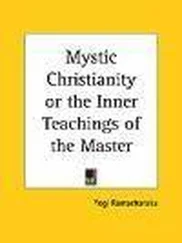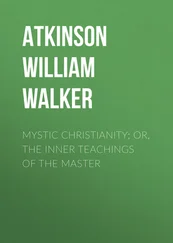Daniel Ingram - Mastering the Core Teachings of Buddha - An Unusually Hardcore Dharma Book
Здесь есть возможность читать онлайн «Daniel Ingram - Mastering the Core Teachings of Buddha - An Unusually Hardcore Dharma Book» весь текст электронной книги совершенно бесплатно (целиком полную версию без сокращений). В некоторых случаях можно слушать аудио, скачать через торрент в формате fb2 и присутствует краткое содержание. Год выпуска: 2009, ISBN: 2009, Издательство: Aeon Books, Жанр: Старинная литература, на русском языке. Описание произведения, (предисловие) а так же отзывы посетителей доступны на портале библиотеки ЛибКат.
- Название:Mastering the Core Teachings of Buddha - An Unusually Hardcore Dharma Book
- Автор:
- Издательство:Aeon Books
- Жанр:
- Год:2009
- ISBN:9781904658405
- Рейтинг книги:5 / 5. Голосов: 1
-
Избранное:Добавить в избранное
- Отзывы:
-
Ваша оценка:
- 100
- 1
- 2
- 3
- 4
- 5
Mastering the Core Teachings of Buddha - An Unusually Hardcore Dharma Book: краткое содержание, описание и аннотация
Предлагаем к чтению аннотацию, описание, краткое содержание или предисловие (зависит от того, что написал сам автор книги «Mastering the Core Teachings of Buddha - An Unusually Hardcore Dharma Book»). Если вы не нашли необходимую информацию о книге — напишите в комментариях, мы постараемся отыскать её.
Mastering the Core Teachings of Buddha - An Unusually Hardcore Dharma Book — читать онлайн бесплатно полную книгу (весь текст) целиком
Ниже представлен текст книги, разбитый по страницам. Система сохранения места последней прочитанной страницы, позволяет с удобством читать онлайн бесплатно книгу «Mastering the Core Teachings of Buddha - An Unusually Hardcore Dharma Book», без необходимости каждый раз заново искать на чём Вы остановились. Поставьте закладку, и сможете в любой момент перейти на страницу, на которой закончили чтение.
Интервал:
Закладка:
can. I have occasionally been laid out on a couch for hours by this aspect of this stage, holding my head and just wishing that these early stages didn’t sometimes involve so much pain and anguish.
There may be odd bodily twistings, obsession with posture, and painful tensions or strange other sensations, particularly in the back, neck, jaw and shoulders. These tensions may persist when not meditating and be quite irritating and even debilitating. The rhomboid 173
The Progress of Insight
and trapezius muscles are the most common offenders. It is common to try to sit with good posture and then find one’s body twisting into some odd and painful position. You straighten out, and soon enough it does it again. That’s a very Three Characteristics sort of pattern. People sometimes describe these feelings as some powerful energy that is blocked and seems wants to get out or move through.
Feelings of heat and sensations like those of a fever may sometimes accompany this stage. One’s neck and back may become very stiff, either on one side or both sides. The right and left sides of one’s body may feel quite different from each other sometimes. The easiest way to get these unpleasant physical manifestations to go away is to keep investigating the Three Characteristics, either of them or of whatever primary object you have chosen. These are common early retreat experiences, particularly in the first few days.
Fighting them or trying other methods (backrubs, etc.) seems to either help only a little, work only temporarily, or sometimes make them even worse, though sometimes hatha yoga and related practices done with a high degree of awareness can be helpful. This is a common time for people to go to health practitioners of various kinds, from orthopedists and dentists to chiropractors and body workers. For example, I had a wisdom tooth removed during one pass through this stage because I thought it was throwing my jaw out of alignment, and perhaps it was, but this was clearly exacerbated by this stage of practice.
Even if these unpleasant physical manifestations do slack off for a bit, they are likely to keep coming back until one’s insight is sufficient to progress beyond this part of this stage. Thus, should one find such things interfering with one’s life, I recommend continued precise and accepting practice. This is a phase of practice when strong effort and very quick investigation really pay off.
Certain traditions may look at such physical manifestations as
“energy imbalances” or in some other negative light, and I can see where they are coming from, but I find those perspectives limiting.
Rather, I see this stage in its broader context as just one more phase of practice. Others may invent very strange stories to explain these experiences. A friend of mine ran into this ñana on retreat, found it very unpleasant, stopped practicing and began to spin out all sorts of fantastic 174
The Progress of Insight
stories in her head about how the poor fellow sitting next to her was very angry and how it was making her tense. This didn’t help whatsoever, and she got stuck there. I have learned to welcome these odd manifestations as clearly recognizable markers of progress on the path.
They are clear objects for practice and reassure me that I am on the right track. Unfortunately, this is a hard lesson to teach others. True, these manifestations can suck, but being able to appreciate what is happening in the face of the difficult stages is important, and becomes much more important later on.
As the mind gains speed at really seeing each of the sensations of the mind and body come and go, and the jerkiness from cause and effect can get quite rapid and pronounced. These physical movements and spasms seem to help break up the physical tension that may sometimes accompany this stage, and are a sign of progress.
4. THE ARISING AND PASSING AWAY
This is also the beginning of the second vipassana jhana. As in the second samatha jhana, the applied and sustained effort or attention begin to drop away, and meditation can seem to take on a life of its own.
In the early part of this stage, the meditator's mind speeds up more and more quickly, and reality begins to be perceived as particles or fine vibrations of mind and matter, each arising and vanishing utterly at tremendous speed. The traditional texts actually call this stage the beginning of insight practices, as from this point on there is a much more direct and non-conceptual understanding of the Three
Characteristics.
This stage is marked by dramatically increased perceptual abilities when compared with the previous stages. For example, one might be able to hone one’s awareness to laser-like precision on the tip of one’s little finger and seemingly be able to perceive the beginning and ending of every single sensation that made up that finger. Spontaneous physical movements and strange jerky breathing patterns that showed up in Cause and Effect and became more pronounced in the Three
Characteristics may speed up significantly. This stage explains where many practices such as Tibetan inner fire practices of the Yogic breath of fire come from. It can also reveal the source material that inspired 175
The Progress of Insight
teachings such as those about chakras and energy channels. Many descriptions of Kundalini awakening are talking about this stage.
Reality is perceived directly with great clarity, and great bliss, rapture, equanimity, mindfulness, concentration, and other positive qualities arise. Practice is extremely profound and sustainable, and there may be no pain even after hours of sitting. Unfortunately, the positive qualities that have arisen can easily become what are called the “Ten Corruptions of Insight” if the true nature of the individual sensations by which they are known are not understood as well, and until this happens a meditator can easily get stuck in the immature part of this stage.
The Ten Corruptions of Insight are: illumination, knowledge, rapturous happiness, tranquility, bliss, resolute confidence, exertion, assurance, equanimity and attachment. To quote the great meditation master Sayadaw U Pandita, from his great but very hard-to-find book, On the Path to Freedom, “As for the practicing yogi, he will at once recognize the above as imperfections of insight not representing dhamma breakthrough and are only to be noted off, remembering the teacher’s advice as to what is path and not path. Being disabled by the ten imperfections, he would not be capable of observing the triple characteristics in their true nature; but once freed from imperfections, he is able to do so.” In short, they may feel that they are now a very mighty meditator and that they should try to hold on to this forever, i.e.
they stop actually doing insight practices and instead solidify these qualities as concentration practice objects. Thus, the advice given about deconstructing and investigating the positive factors of the samatha jhanas, particularly the second one, is also very helpful when trying to stay on the narrow path of the progress of insight.
Visions, unusual sensory abilities (such as seeing nearby things through one’s closed eyelids), out of body experiences, and especially bright lights tend to arise to the meditator, sometimes first as jewel-tone sparkles and then as a bright white light (“I have seen the light!”). The technical meditator may easily sit for hours dissecting their reality into extremely fine and fast sensations and vibrations, perhaps even up to 40
per second or even more, with an extremely high level of precision and consistency. (Where the absurd and disheartening rumors of billions of mind moments per second come from is beyond me). Fine vibrations 176
The Progress of Insight
may spread over the body, revealing interference patterns between experiences, enabling one to know directly that when one thing is experienced, in that instant, something else is not.
Читать дальшеИнтервал:
Закладка:
Похожие книги на «Mastering the Core Teachings of Buddha - An Unusually Hardcore Dharma Book»
Представляем Вашему вниманию похожие книги на «Mastering the Core Teachings of Buddha - An Unusually Hardcore Dharma Book» списком для выбора. Мы отобрали схожую по названию и смыслу литературу в надежде предоставить читателям больше вариантов отыскать новые, интересные, ещё непрочитанные произведения.
Обсуждение, отзывы о книге «Mastering the Core Teachings of Buddha - An Unusually Hardcore Dharma Book» и просто собственные мнения читателей. Оставьте ваши комментарии, напишите, что Вы думаете о произведении, его смысле или главных героях. Укажите что конкретно понравилось, а что нет, и почему Вы так считаете.












